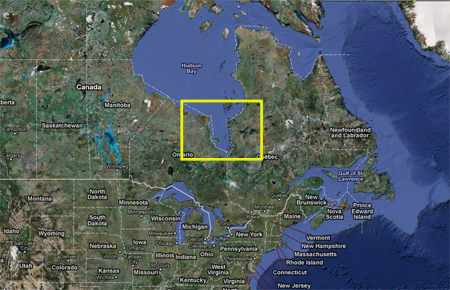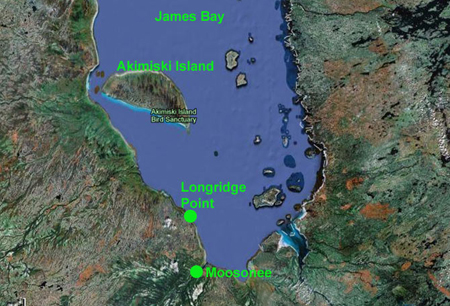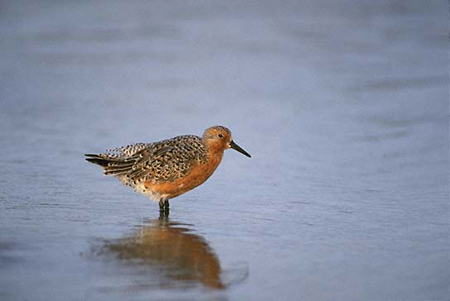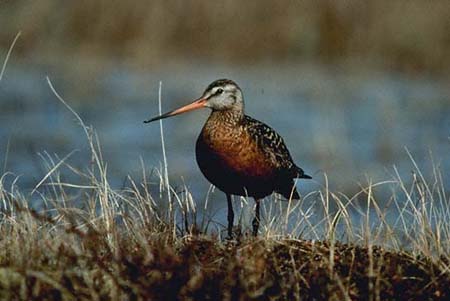A little over a week ago we posted an update from Ron Pittaway, who has been writing up the bird counts from Jean Iron up in in the James Bay region of Canada and posting them on the Ontario Birding listserv. Jean is part of a group that heads up to this remote part of Canada every year to conduct bird counts, providing critical information about bird trends and behavior in a region with little researching infrastructure.
The two have been communicating by satellite phone and Ron has been posting the updates on the Ontario Birding listserv.

James Bay region of Canada
Credit: Google Earth with highlighted box added by David Childs
Here is a link to the first update, which Ron was kind enough to let us share on the blog. Below are the second and third updates from Jean, written up by Ron. Hope you enjoy them - sounds like there has been a lot of activity!
__________________________________________________________
This is Jean Iron's second report on 23 July 2010 by satellite phone for
the period 18-22 July from Longridge Point on the south coast of James
Bay. The Royal Ontario Museum study of Red Knots and shorebirds is a
cooperative effort with the Ontario Ministry of Natural Resources
(OMNR), Canadian Wildlife Service (CWS) and Trent University.

SHOREBIRD OBSERVATIONS
The past several days have been mainly sunny with daytime high
temperatures below average with cool nights. High tides have been weak
so shorebirds were less concentrated for counting. Usually only high
count day numbers for each species are listed below in checklist order.
Black-bellied Plover: 2 adults on 20-21 July.
Semipalmated Plover: 26 probable adults in flight on 22 July.
Killdeer: 10 on 21 July. Late nest with 4 eggs hatched on 22 July.
Greater Yellowlegs: 137 mostly adults on 19 July.
Lesser Yellowlegs: 480 (1/3 juveniles) on 18 July.
Whimbrel: 78 adults on 20 July.
Hudsonian Godwit: 222 molting adults on 19 July. Adult Hudsonian Godwits
molt body feathers before migrating from James Bay usually going nonstop
to South America in late August and early September.
Marbled Godwit: None seen.
Ruddy Turnstone: 102 on 22 July appeared to be mostly females in worn
alternate plumage.
RED KNOT: Highest count to date of 638 molting adults on 20 July is half
the number for same period in 2009. 69 flagged individuals observed
include birds banded in the United States, Brazil, Argentina and Chile.
The above include 7 birds marked before 2005. One with a data logger
from Delaware Bay (USA) observed on 20-21 July. After breeding in the
Canadian Arctic, rufa Red Knots migrate to stopover areas such as
southern James Bay, where they fatten for the long flight to South
America. Another rufa population winters in Florida. Florida knots are
rare in James Bay. Longridge was chosen as the ROM's survey site because
high numbers were recorded there in the past. A one-day estimate of 5000
at Longridge was made in the late 1970s before the decline.

The team has put special emphasis on counting and tracking Red Knots.
Credit: Tom Vezo
Sanderling: 22 fading and molting adults on 18 July.
Semipalmated Sandpiper: 1095 adults (no juveniles) on 22 July.
Least Sandpiper: first juvenile on 17 July. 80 (1/2 juveniles) on 20
July.
White-rumped Sandpiper: 109 molting adults on 22 July.
Pectoral Sandpiper: 540 adults (not molting) on 20 July.
Dunlin: 11 worn adults not yet in active molt on 22 July.
Stilt Sandpiper: 2 molting adults on 21-22 July.
Short-billed Dowitcher: 6 adults (not molting) on 19 July comprised 2
nominate subspecies griseus and 4 hendersoni. 8 on 21 July were mostly
hendersoni. 1 nominate griseus on 22 July.
Wilson's Snipe: 4 still winnowing on 19 July.
WILSON'S PHALAROPE: One juvenile on 21 July found by Mark Peck and Lisa
Pollock. It likely hatched locally because this phalarope breeds
sparingly in the prairie-like marshes of James Bay.
OTHER SIGHTINGS
Birds: American White Pelican seen daily with high of 57 on 20 July.
Sandhill Crane. Yellow Rail numbers are much lower than last summer
possibly linked to drier marshes this year. Some Yellow Rails may have
short-stopped to breed in the areas such as southern Manitoba, which is
very wet this summer with many reports of singing Yellow Rails.
Short-eared Owl, pair with two young. Gray Jay, pair with a blackish
juvenile. Swainson's Thrush singing. Orange-crowned Warbler singing. Le
Conte's Sparrow nest with eggs on 22 July. Nelson's Sparrow nest with
eggs on 19 July. Small numbers of White-winged Crossbills and Common
Redpolls seen most days.
Mammals: A dead Beluga, 3 metres in length, washed up on shore. Crew
hopes the carcass will attract scavengers such as Red Fox, Gray Wolf and
Lynx whose tracks have been seen during surveys. Two Black Bears seen on
19 July. A Caribou on 19 July. A Short-tailed Weasel (Mustela erminea)
is around camp.
Butterflies: Two additions since last report: Skipper sp. (genus
Polites) and Northern Crescent.
Map link below of southern James Bay. Yellow pointer shows location of
Longridge Point. Ontario borders the west coast of James Bay and Quebec
borders the east coast. Provincial boundaries extend to the low water
mark on James Bay. Offshore islands extending to the low water mark are
part of Nunavut Territory. The waters and seabed of James Bay are
internal parts of Canada under exclusive federal jurisdiction and not
part of Ontario, Quebec or Nunavut.
www.jeaniron.ca/2009/James-Bay-2009-REKN.jpg
Jean will call again in 4-6 days and I'll post her third report.
Ron Pittaway
Minden, Ontario
__________________________________________________________
This is Jean Iron's third report by satellite phone on 1 August 2010 for
the period 23 July to 1 August 2010 from Longridge Point on southern
James Bay. Jean is a volunteer surveying Red Knots and other shorebirds
under the direction of Mark Peck of the Royal Ontario Museum, Toronto.

On 31 July four more people arrived at camp and one there departed. Don
Sutherland of the Ontario Ministry of Natural Resources (OMNR), Mike
McMurtry (OMNR), Doug McRae (ROM volunteer) and Ray Ford (writer)
arrived and Christian Friis (Canadian Wildlife Service) left. Mark Peck,
Lisa Pollock (Trent University/OMNR) and Jean Iron are staying until the
survey ends about 15 August. Seven people are in camp.
SHOREBIRD MIGRATION CHRONOLOGY: Most (not all) southbound shorebirds
migrate in three waves: females first, males second, juveniles last.
Females depart soon after the young hatch leaving the males to raise the
young. The males depart about 2-3 weeks later when the juveniles have
grown. Then juveniles migrate after the males.
SHOREBIRD OBSERVATIONS
About 7000 shorebirds are currently in the Longridge Point area. There
are no Peregrine Falcons to disrupt their feeding. Best day for high
counts was 29 July after a storm. For most species only the high count
day is given below in checklist order.
Black-bellied Plover: 21 molting adults on 29 July.
American Golden-Plover: 2 adults on 25 July.
Semipalmated Plover: 97 on 29 July.
Killdeer: 26 on 29 July.
Spotted Sandpiper: 9 on 31 July.
Greater Yellowlegs: 209 (1/2 juveniles) on 29 July.
Lesser Yellowlegs: 437 mostly juveniles on 28 July.
Whimbrel: 51 on 23 July.
Hudsonian Godwit: 392 molting adults on 29 July.

Hudsonian Godwits have been quite numerous in their counts.
Credit: Dale & Marian Zimmerman
Marbled Godwit: None.
Ruddy Turnstone: 415 adults on 29 July.
RED KNOT: The high count of 1143 molting adults was on 29 July. The
extensive tidal flats of southern James Bay are an important stopover
area for knots. 120 marked individuals have been observed with several
birds seen over a period of 12-14 days indicating a long stay. Mark Peck
and shorebird researcher Lisa Pollock are sampling the foods eaten by
the knots. They noted that the knots are plump and in excellent
condition. These knots will likely fly nonstop to South America.
Migrating knots that fail to gain adequate weight suffer reduced
survival.
Sanderling: 20 molting adults on 25 July.
Semipalmated Sandpiper: 4338 mostly adults on 31 July, first juveniles
(a few) on 30th.
WESTERN SANDPIPER: 2 on 29 July seen by Mark Peck.
Least Sandpiper: 126 mainly juveniles on 31 July.
White-rumped Sandpiper: 2450 molting adults on 31 July. A few are still
in almost full but heavily worn alternate plumage.
Pectoral Sandpiper: 520 adults (not molting) on 29 July.
Dunlin: 34 adults still in full worn alternate plumage on 26 July.
BUFF-BREASTED SANDPIPER: 1 on 25 July seen by Lisa Pollock.
Short-billed Dowitcher: 2 juveniles on 24 July, 5 juveniles on 29th.
Wilson's Snipe: 4 on 28 July.
Wilson's Phalarope: 1 juvenile previously reported on 21 July, 1 adult
(probable male with cinnamon on sides of neck) on 29th, 1 juvenile on
30th. A sparse population breeds at James Bay.
Red-necked Phalarope: 1 molting adult on 29 July.
SEA LEVEL RISE: Sea levels could rise one metre by 2100 and will
continue rising. Ontario's low flat coastline of James Bay is extremely
vulnerable. Rising sea levels will inundate or change vital shorebird
habitats.
OTHER SIGHTINGS
Birds: Black Scoter, a few seen but not the big flocks of molting males
seen last summer. Red-throated Loon. 92 American White Pelicans on 1
August. Yellow Rail, 6 ticking on 1 August. Osprey. Northern Harrier.
Northern Goshawk on 1 August. Merlin. An adult Great Black-backed Gull
is regular. Little Gull, 1 adult of 23 and 29 July was in wing molt.
Bonaparte's Gull, 356 on 30 July with some adults in wing molt, first
juveniles on 23 July. Bonaparte's and Little Gulls in wing molt suggest
that some birds of these species undergo prebasic molt close to the
breeding grounds. Arctic Terns seen daily including a pair feeding 3
young on 27 July. Common Tern, 2 on 31 July. Adult light morph Parasitic
Jaeger on 29 July. Short-eared Owl observed doing a "food drop" to young
in the grass. Yellow-bellied Flycatcher on 1 August. Rusty Blackbird.
Philadelphia and Red-eyed Vireos. Tennessee, Orange-crowned, Cape May,
Bay-breasted, and Blackpoll Warblers. Le Conte's and Nelson's Sparrows
still singing, Nelson's nest with 4 young. 1 Purple Finch. White-winged
Crossbills daily. Common Redpolls regular.
Mammals: Black Bears are seen daily including a female with two cubs and
a female with one cub. No problem bears around camp. A dead young Beluga
(White Whale) washed up on shore. It could be the calf of the adult that
washed up earlier. Young Snowshoe Hare around camp. Short-tailed Weasel
regular at camp. Striped Skunks 2.
Butterflies: New since the last report are Atlantis Fritillary and
American Lady.
FOREST FIRES: There are currently very few forest fires burning in
Ontario's boreal forest and Hudson Bay Lowlands. Most fires north of the
commercial timber zone are allowed to burn unless they threaten
lives/property and First Nation (Cree) communities.
Southern James Bay map shows location of Longridge Point
www.jeaniron.ca/2010/longridgemap.jpg
Jean will call again in a week and I'll post another update.
Ron Pittaway
Minden, Ontario

